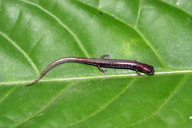|
Thorius smithi Hanken & Wake, 1994
Smith's Minute Salamander | family: Plethodontidae subfamily: Hemidactyliinae genus: Thorius |
 © 2010 Sean Michael Rovito (1 of 3) |
|
|
Author: Jean Raffaëlli Thorius smithi Hanken et Wake, 1994 Petite forme de basse altitude de la Sierra de Juarez. Dents présentes sur les maxillaires. 2 cm SVL (F). Forme fine, narine assez grande, légèrement ovale, museau tronqué. Mains et pieds très petits, queue longue, dépassant le reste du corps. Coloration sombre, bande dorsale obscure, plus claire de l’œil à la queue. La bande est bordée d’une ligne dorso-latérale sombre qui se poursuit sur la queue. Flancs, dessus des membres et parties ventrales plus clairs couverts de taches blanches. Très basse altitude pour le genre, entre 800 m (près de Metates) et 1 550 m (Vista Hermosa), en forêt de brume le long de la route 175, sous des morceaux de bois à terre et sous une pierre. 19 km2. DD. Très peu connue. It is a small, from of lowland of the Sierra de Juarez. There are teeth on the maxillary bones. 2Cm SVL (F). It is slender, with slightly oval and big nostrils. The snout is truncated. Hands and feet are very small, the tail is long, longer than the rest of the body. It is dark with a lighter dorsal stripe from the eye to the tail. The stripe is bordered by dorsolateral dark lines which also continue on the tail. The flanks, the dorsal side of the limbs, and ventral parts are lighter with white spots. Habitat & Range: It lives at rather low altitudes compared with other species of the genera, between 800 (near Metales) and 1550m (Vista Hermosa) above sea level. It lives in cloud forests, along the road 175, under dead wood on the ground or rocks. 19Km2. Conservation: Data deficient. It is not well known at all. Feedback or comments about this page.
Citation: AmphibiaWeb. 2025. <https://amphibiaweb.org> University of California, Berkeley, CA, USA. Accessed 16 Jun 2025. AmphibiaWeb's policy on data use. |


 Raffaëlli Account
Raffaëlli Account Map of Life
Map of Life
 ENGLISH TRANSLATION - Julian Wittische
ENGLISH TRANSLATION - Julian Wittische